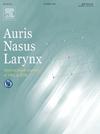同时用显像透视和宫颈吞咽声记录分析耳内吞咽声。
IF 1.5
4区 医学
Q2 OTORHINOLARYNGOLOGY
引用次数: 0
摘要
目的:Haji等人报道了在吞咽反射过程中,用放置在耳中的小型lavalier麦克风记录了典型的咔哒声。他们还报告说,内窥镜和光管观察表明,这些声音可能与吞咽时咽鼓管的打开和关闭有关。在本研究中,我们同时进行了透视录像和耳内吞咽音记录,同时记录了耳内吞咽音和宫颈吞咽音,进一步验证了耳内吞咽咔嗒声反映了耳咽管的打开和关闭。此外,我们试图评估这些声音的特征和有用性,以评估吞咽功能和研究吞咽动力学。方法:我们对27例无耳部病变且吞咽功能正常的患者同时进行了透视和耳内吞咽录音,并对25例没有主观吞咽困难或耳部疾病的健康青年同时进行了耳内和颈部吞咽录音。耳内吞咽声由放置在耳内的lavalier麦克风记录。通过同时录像透视和耳内吞咽声记录,确定耳内吞咽咔嗒声的上升点、鼻咽闭合点、造影剂到达下咽点、喉部最大抬高点,并分析它们的时间关系。在干咽和水咽时,同时记录的耳内吞咽音和颈部吞咽音之间的差异也进行了研究。结果:在鼻咽闭合前立即出现耳内吞咽咔嗒声,随后造影剂到达下咽和喉部抬高。在所有吞咽唾液和水的病例中,均观察到耳内吞咽咔嗒声先于颈椎吞咽声。相反,宫颈吞咽声没有记录到相应的咔哒声。发现水吞咽和唾液吞咽时,耳内吞咽咔嗒声的发生时间与颈部吞咽声最大声压的间隔有显著差异。结论:本研究的结果表明,耳内吞咽咔嗒声是由咽鼓管在吞咽过程中打开和关闭时产生的,并作为吞咽反射开始其序列的恒定点的时间指标。因此,记录和分析耳内吞咽咔哒声可以成为研究吞咽动力学和评估吞咽功能的有用工具,而无需昂贵的设备。值得注意的是,这些咔嗒声可能受到耳咽管功能的影响。本文章由计算机程序翻译,如有差异,请以英文原文为准。
Intra-aural swallowing sound analysis with simultaneous videofluoroscopy and cervical swallowing sound recording
Objective
Haji et al. reported that characteristic click-like sounds during the swallowing reflex were recorded with a small lavalier microphone placed in the ear. They also reported that endoscopic and phototubometric observations showed that these sounds were likely related to the opening and closing of the Eustachian tube during swallowing. In the present study, we performed simultaneous videofluoroscopy and intra-aural swallowing sound recording, as well as simultaneous recording of intra-aural and cervical swallowing sounds, to further verify that intra-aural swallowing click sounds reflect the opening and closing of the Eustachian tube. Additionally, we sought to evaluate the characteristics and usefulness of these sounds for evaluating swallowing function and studying swallowing dynamics.
Methods
We performed simultaneous videofluoroscopy and intra-aural swallowing sound recordings in 27 patients without ear lesions whose swallowing function was evaluated as normal, and simultaneous intra-aural and cervical swallowing sound recordings in 25 healthy young adults without subjective dysphagia or ear disease. Intra-aural swallowing sounds were recorded with a lavalier microphone placed in the ear. From simultaneous videofluoroscopy and intra-aural swallowing sound recordings, the point of rise of the intra-aural swallowing click sound, the point of nasopharyngeal closure, the point where the contrast medium reached the hypopharynx, and the point of maximum elevation of the larynx were determined, and their temporal relationship was examined. The differences between the simultaneously recorded intra-aural and cervical swallowing sounds were also investigated in dry and water swallowing.
Results
Intra-aural swallowing click sounds occurred immediately before nasopharyngeal closure, followed by contrast medium reaching the hypopharynx and laryngeal elevation. Intra-aural swallowing click sounds were observed to precede cervical swallowing sounds in all cases of both saliva and water swallowing. Conversely, no corresponding click sounds were recorded in cervical swallowing sounds. The interval between the onset of the intra-aural swallowing click sounds and the maximum sound pressure of the cervical swallow sound was found to be significantly different between water and saliva swallowing.
Conclusions
The results of this study suggest that intra-aural swallowing click sounds are produced by the opening and closing of the Eustachian tube during swallowing and serve as a temporal indicator of the constant point at which the swallowing reflex begins its sequence. Therefore, recording and analyzing intra-aural swallowing click sounds could be a useful tool for studying swallowing dynamics and assessing swallowing function without the need for expensive equipment. It is important to note, however, that these click sounds may be influenced by Eustachian tube function.
求助全文
通过发布文献求助,成功后即可免费获取论文全文。
去求助
来源期刊

Auris Nasus Larynx
医学-耳鼻喉科学
CiteScore
3.40
自引率
5.90%
发文量
169
审稿时长
30 days
期刊介绍:
The international journal Auris Nasus Larynx provides the opportunity for rapid, carefully reviewed publications concerning the fundamental and clinical aspects of otorhinolaryngology and related fields. This includes otology, neurotology, bronchoesophagology, laryngology, rhinology, allergology, head and neck medicine and oncologic surgery, maxillofacial and plastic surgery, audiology, speech science.
Original papers, short communications and original case reports can be submitted. Reviews on recent developments are invited regularly and Letters to the Editor commenting on papers or any aspect of Auris Nasus Larynx are welcomed.
Founded in 1973 and previously published by the Society for Promotion of International Otorhinolaryngology, the journal is now the official English-language journal of the Oto-Rhino-Laryngological Society of Japan, Inc. The aim of its new international Editorial Board is to make Auris Nasus Larynx an international forum for high quality research and clinical sciences.
 求助内容:
求助内容: 应助结果提醒方式:
应助结果提醒方式:


